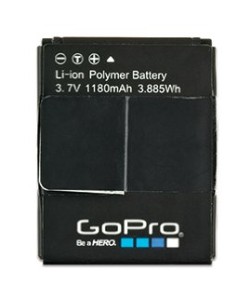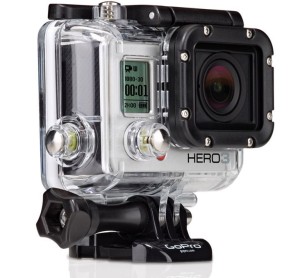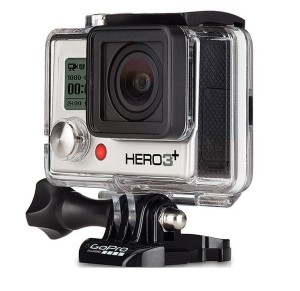JULY 2015 UPDATE – this article deals with the GoPro Hero 3 and 3+ range of cameras released in 2013 (but still available for sale) – to check our our advice on the latest GoPro models please see this updated article!
As we describe in more detail in our overall guide to the GoPro Hero 3 range, GoPro now offer three colour-coded models – white, silver and black – which, to the untrained eye, all look pretty much identical. And, in fact, there are a significant number of features which are identical as between the cameras. However, this page aims to set out clearly exactly what the differences are and – more importantly – the impact they might have on your intended use of the action cam!
Facing off in this article are the GoPro Hero 3 White and the GoPro Hero 3+ Silver. The first thing to note is that extra “+” after the 3 in the Silver’s title. This is to indicate that the Silver (and indeed the Black) got a “mid series” spec update in October 2013, while the White’s technical specification has remained unchanged.
However, somewhat confusingly, all of the Hero 3 cameras have had an upgrade to their case designs – the telltale sign is that the newer case (on the right below) lacks the bolts around the lens housing, and has larger buttons. It’s still possible to buy both the old version of the Hero 3 White and the Silver “non-plus” model, so it is worth being aware of this change so you know what you’re paying for!
So, into the comparison of the new Hero 3 White against the Hero 3+ Silver. Firstly, it is important to establish what features are identical between the two cameras:
- Case design – both are waterproof to 131 feet / 40 metres
- Size and weight – both weigh 4.8 oz (136g) in the waterproof housing
- Storage – both can support up to a 64GB micro-SD card
- Connectivity – both have built in wifi, and can be used with (but do not come with) the GoPro wifi remote
- Ports – both feature a mini-USB port and a micro-HDMI port
So, physically the cameras look and feel the same, and obviously they share the same mounting system. As such, the key difference is in their available recording modes and qualities:
| Resolution | GoPro Hero 3 White | GoPro Hero 3+ Silver |
|---|---|---|
| 1080p | 30 fps Medium FOV | 60 fps Ultra-wide, medium & narrow FOV |
| 960p | 30 fps Wide FOV | 60 fps Wide FOV |
| 720p | 60 fps Ultra-wide FOV | 120 fps Ultra-wide, medium & narrow FOV |
| WVGA | 60 fps Ultra-wide FOV | 120 fps Ultra-wide FOV |
| Still photos | 5 megapixels wide angle 3 photos a second burst | 10 megapixels wide angle 10 photos a second burst |
Video modes
As can be seen from the table above, at every resolution, the GoPro Hero 3+ Silver is able to shoot at double the framerate of the White model. This increased framerate for the Silver has two advantages. Firstly, the footage looks smoother when played back at its ‘native’ speed on a home computer – though it’s doubtful whether at full speed you would be able to discern much difference between framerates above 60fps. It’s also worth noting that YouTube now supports 60fps footage – previously the limit was only 30fps.
The second big advantage of higher framerates is the ability to create a smooth slow motion effect. Given that 30fps is the lowest framerate you can go to without it looking jerky, the White only realistically allows video to be slowed down to half speed at 720p (60 to 30fps), and not at all at 1080p. In comparison, the Silver allows footage to be slowed down to a quarter of its native speed at 720p (120 to 30fps), and to half speed at 1080p. The Silver is therefore definitely the camera of choice if you’re interested in experimenting with slow motion effects.
It’s also worth noting that the GoPro Hero 3 White can only shoot at 1080p in what GoPro calls it “medium” field of view -this equates to around 127 degrees. Meanwhile, the Silver gives the option of shooting at the ultra-wide (170 degrees), medium and narrow fields.
Still photos
As can also be seen from the last line in the table, the GoPro Silver can also shoot 10MP still photos in a burst of 10 photos per second, while the White can only manage half the resolution at 5MP, and a third of the burst rate at 3 photos per second. This makes the Silver the better choice for anyone who is looking to use the camera for stop motion type photography.
Audio
The basic audio specs between the GoPro Hero 3 White and the 3+ Silver are the same – each can record in mono at 48kHz using AAC compression. However, GoPro claim that the Hero 3+ Silver has an improved sensitivity of around 10dB in comparison to the White, and can handle twice the volume of the White without distortion. While this may be so, it remains the case that the audio quality on the GoPro is not its strongest point – when used in the waterproof case the sound is often quite muffled, and at speed it is often lost in a roar of wind noise in any event. As such, we don’t consider that audio quality is a particularly good reason to chose between the cameras.
Battery life
 Interestingly, although the White and the Silver look physically identical, GoPro has
Interestingly, although the White and the Silver look physically identical, GoPro has
equipped them with slightly different batteries. The White’s battery has a capacity of 3885mWh, while the Silver ups this to 4366mWh – around 12% more (and in fact, the replacement batteries that GoPro sells are all the higher capacity batteries):
This translates into estimated battery life as follows:
| Resolution | GoPro Hero 3 White | GoPro Hero 3+ Silver |
|---|---|---|
| 1080p 60fps | - | 2 hr 15 min |
| 1080p 30fps | 2 hr 15 min | 3 hr 0 min |
| 720p 120fps | - | 2 hr 20 min |
| 720p 60fps | 2 hr 15 min | 2 hr 45 min |
As can be seen, the extra juice in the Silver’s battery gives it between 30 and 45 minutes of extra recording time at the comparable video resolutions. Of course, the actual life of the battery will vary significantly depending on the ambient temperature, and will inevitably decrease over repeated charge and discharge cycles, but still the Silver does seem to have a distinct advantage in this regard.
Conclusion
It’s always difficult to write a conclusion after an article like this – ultimately, which camera is best for a particular user depends on how they are going to use it, their budget, and whether they simply want to have the highest spec camera regardless of whether they really ‘need’ it. So, I’ve set out a few thoughts below, which might hopefully help make up your mind:
- Apart from the obvious price increase, there is no disadvantage to buying the Silver over the White – it’s an upgrade across the board
- The Silver is the only real option if you want to shoot in 1080p rather than 720p – the White is too limited at the full HD resolution
- Likewise, the Silver is the better option if you’re very keen on slow motion footage, particularly given its 720p at 120fps setting
- Bursts of still shots are significantly better on the Silver
- If you don’t want slow motion, and are happy at 720p (or using a medium field of view at 1080p), and don’t plan on using the burst still shot options, then the White does everything you could need it to do!
Ultimately, the GoPro Hero 3+ Silver at around $300 is half as much again as the White at $200 – and that $100 will buy you a significant number of additional mounts (or go towards your ski, surf or road trip!) Then again, if you can stretch to it, and if you’re going to make use of it, the extra functionality of the Silver is extremely attractive.
Click here to check out the latest price for the GoPro Hero 3+ Silver…
…And click here to check out the latest price for the GoPro Hero 3 White!


